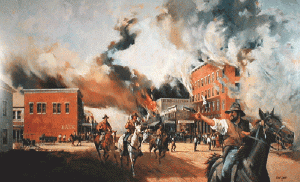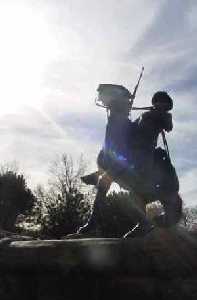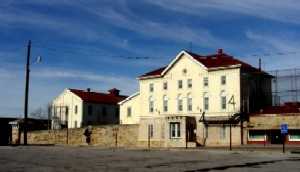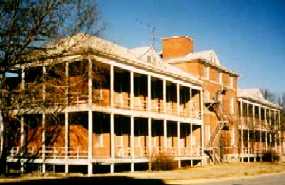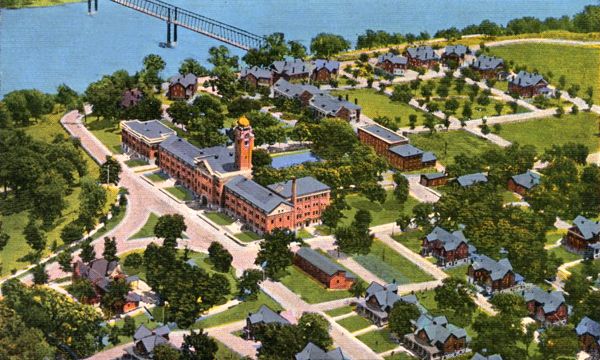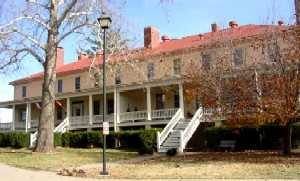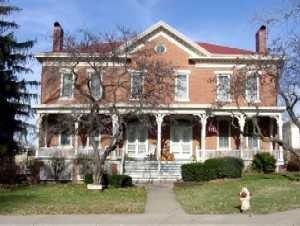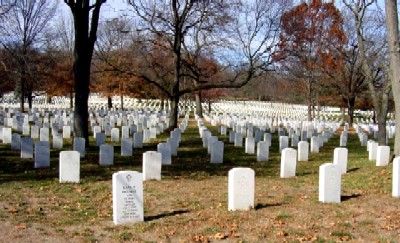Fort Leavenworth History
Fort Leavenworth, Kansas, first known as Cantonment Leavenworth, was established by Henry Leavenworth on the Missouri River on May 8, 1827. Fort Leavenworth was the first settlement in Kansas territory and is the oldest active Army post west of the Mississippi River. Sitting on the bluffs overlooking the western bank of the Missouri River, the fort initially served as a quartermaster depot, arsenal, and troop post. It was dedicated to protecting the fur trade and safeguarding commerce on the Santa Fe Trail.
The post was evacuated in May 1829 and occupied by Kickapoo Indians until it was re-garrisoned in the fall of 1829. The name of the post was changed to Fort Leavenworth on February 8, 1832.
Fort Leavenworth quickly became a primary destination for thousands of soldiers, surveyors, and settlers who were passing through on their way to the vast West. During these early years, soldiers from Fort Leavenworth protected wagon trains hauling supplies over the Santa Fe, Oregon, and other trails to most forts, posts, and military camps of the West, some as far as the Pacific Ocean. In 1839, Colonel Stephen W. Kearny marched against the Cherokee with ten companies of dragoons, the largest U.S. mounted force ever assembled.
After the Kansas-Nebraska Act was passed in 1854, the Army spent much time attempting to keep the lid on the pot of trouble between the proslavery bushwhackers and the free soil jayhawkers in the Bleeding Kansas era.
Military expeditions from Fort Leavenworth under General Albert Sidney Johnston also assisted in 1857-58 with bringing the Mormons in Utah under Brigham Young back under federal control.
During the Civil War, thousands were recruited and mustered out from Camp Lincoln at Fort Leavenworth. Between 1861 and 1865, the regular army formed the foundation on which volunteer forces were built. Fort Leavenworth was considered a rich prize by Confederate General Sterling Price, who advanced towards the fort in 1864. Before reaching the fort, however, he was defeated in the battle of Westport, Missouri, on October 23, 1864.
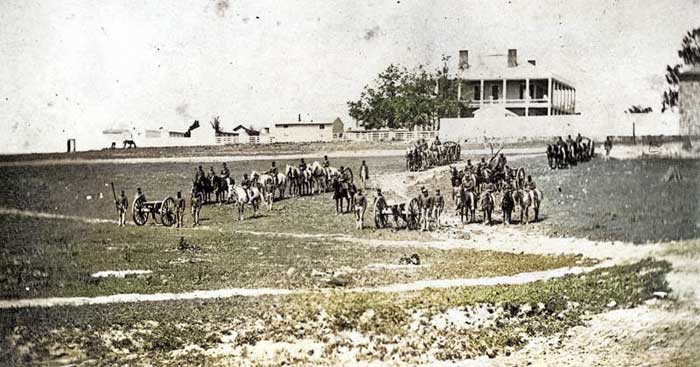
Fort Leavenworth – African American Battery circa 1864. Touch of color by LOA .
Railroads stretching towards the west came under increasing attack by the Plains Indians during the Civil War. Because the western posts were undermanned, Confederate prisoners were called upon to help fight the hostile Indians. Five of these regiments were outfitted at Fort Leavenworth.
For the next 30 years, Fort Leavenworth became the chief base of operations on the Indian frontier; their primary mission – to control the American Indian tribes on the Western plains. Between 1865 and 1891, the Army had more than 1,000 combat engagements with Apache, Modoc, Cheyenne, Ute, Nez Perce, Comanche, Kiowa, Kickapoo, and other tribes. The Indians wanted to maintain their lands and freedom, and the United States government wanted to place the Indians on reservations. With the constant breaking of treaties and an inability to send the Indians promised supplies, the Indians did not feel compelled to keep treaties on their own end. Fort Leavenworth was directly involved in the Indian Wars through 1878 when Chief Joseph’s Nez Perce tribe was detained at the fort after their defeat in 1877.
In 1866, the U.S. Congress authorized the formation of four black regiments – the 24th and 25th Infantry Regiments and the 9th and 10th Cavalry Regiments. The 10th Cavalry Regiment was formed at Fort Leavenworth under the command of Colonel Benjamin H. Grierson on September 21, 1866. In western Kansas, the Kiowa encountered the soldiers of the 10th and, finding them valiant opponents, termed them the “Buffalo Soldiers.”
In time, the term was used for the black soldiers in four regiments. The Buffalo Soldiers left Fort Leavenworth to win repeated honors on the plains and the west. In 1898 the Buffalo Soldiers fought in Cuba, winning praise from Theodore Roosevelt and his Rough Riders for their critical role in the battle for Santiago.
The Buffalo Soldiers also served on the Mexican border before the American entry into the First World War. Today a monument stands at Fort Leavenworth in tribute to the Buffalo Soldiers of the 9th and 10th Cavalry Regiments.
In 1875, the United States Disciplinary Barracks were established and continued operations through 2002, when new barracks were built. The barracks are the only maximum-security prison in the Department of Defense, serving all military branches.
The old barracks once held more than 1,000 prisoners, though the new building houses just over 500. In later years, the barracks became the temporary home of many Nazi prisoners before they were executed at the Fort. “Rocky” Graziano got his start in boxing at the barracks.
The fort’s first Catholic Church was built in 1871 and was later replaced by St. Ignatius Chapel in 1889. St. Ignatius Chapel was destroyed by fire in December 2001, and its foundation is preserved in a memorial park. The first Protestant Memorial Chapel was built by prison labor in 1878 of stone quarried on the post.
With the end of the Indian Wars, the fort became an integral part of the Army’s new officer education system and a worldwide model for military corrections. In 1881, General William T. Sherman established the School of Application for Cavalry and Infantry, which later evolved into the U.S. Army Command and General Staff College. Some of the many famous students and instructors at the college are George C. Marshall, Dwight D. Eisenhower, Douglas MacArthur, Colin Powell, and George Patton.
In 1885, the Wadsworth of Old Soldiers Home was built and later became the Veterans Administration Center. In 1893, the Immanuel Chapel, made famous in Ripley’s ‘Believe It or Not,’ was built on the VA grounds.
World War I proved the wisdom of Sherman’s initiative. Fort Leavenworth graduates excelled in planning complex American Expeditionary Forces operations. By the war’s end, they dominated staffs throughout the Expeditionary Forces.
In the years between the World Wars, Fort Leavenworth General Staff College graduates included such officers as Dwight D. Eisenhower, Omar N. Bradley, and George S. Patton. During World War II, some 19,000 officers completed various courses at Fort Leavenworth. By the end of 1943, commanders and staff of 26 infantry, airborne, and cavalry divisions had trained as teams at the school.
In 1946, the school was given its current name. In 1959, the college moved into J. Franklin Bell Hall on Arsenal Hill. In 1985, the Harold K. Johnson wing was added to house the Combined Arms and Services Staff School. Eisenhower Hall was dedicated in 1994. Classes for the School of Advanced Military Studies, the School for Command Preparation, and the Combined Arms Research Library are in Eisenhower Hall.
The Combined Arms Center (CAC) was created in 1973. The senior headquarters on the post, CAC, has had responsibilities in training, doctrine, and leader development since it was created. Today, through its major subordinate organizations and associated schools and centers, CAC has the mission of preparing the Army and its leaders for war as the Center for Excellence in leader development, doctrine, collective training, and battle command.
The Lewis and Clark Center, the new home of the Command and General Staff College, opened in 2007. The $115 million state-of-the-art training center includes 96 classrooms for more than 1,500 students and 600 faculty members.
In addition to training facilities, the post still houses active soldiers, including the 35th Infantry Division.
Though the fort allows visitors, and the general public is welcome to enter the post without a military ID, all visitors older than 16 need a valid government ID card, such as a driver’s license, passport, or military ID, to enter the post. Vehicles must have current tags, proof of insurance, and registration. Upon arrival, vehicles are subject to search.
Visitors to Fort Leavenworth may enter either at the Main Gate near North 7th Street or Hancock Gate near North 20th Street. Both entrances are located off Metropolitan Avenue (US-73/KS-92/7). Fort Leavenworth is located two miles north of the city of Leavenworth on Hwy 73 in the northeastern corner of Kansas.
Scattered across the main post area are limestone pedestals, which are part of the Historical Fort Leavenworth Wayside Tour. These pedestals provide information and audio narratives describing the history of each site. The self-guided tour begins at the Frontier Army Museum, which tells the story of Fort Leavenworth and the Frontier Army with its extensive collection of weapons, uniforms, and equipment. The main exhibit gallery presents the history of the Army west of the Mississippi River from 1817 to 1917. The museum is located at 100 Reynolds Avenue.
More Information:
Frontier Army Museum
100 Reynolds Avenue
Leavenworth, Kansas 66027
913-684-3767
Fort Leavenworth Hauntings
Several old officers’ houses on historic Fort Leavenworth are haunted, faces can be seen in the back of the fireplaces and strange noises heard at night. Many believe the ghosts are spirits of inmates who were executed at the United States Disciplinary Barracks on Fort Leavenworth and the ghosts of those buried in the National Cemetery located just beyond the prison walls.
The Chief of Staff’s Quarters at 624 Scott Avenue to continue to host a tea party in the parlor. Though apparitions have not been seen, several people report hearing the sounds of a tea party coming from an otherwise empty parlor.
Former Site of St. Ignatius Chapel – The original St. Ignatius Chapel was built where a house now stands at 632 Thomas Avenue. In 1875, the original church and rectory burned down, claiming the life of a young priest who had been assigned there. After the fire, the salvageable building material was used to build the new residence.
Some of the scorched bricks can still be seen making up the fireplace in the house’s dining room. Etched into these bricks are several names, including that of Father Fred. Many who have lived there have claimed to see Father Fred walking through the house in his priestly robes. Reportedly, he is most often seen walking up and down the stairs and in the kitchen and dining room. In the 1970s, his robed figure appeared in a Polaroid photograph taken at a dinner party.
After the first chapel burned down in 1875, a new one was built at the corner of McClellan and Pope. However, on December 16, 2000, in the early morning hours, it burst into flames and was completely destroyed. It makes one wonder if there isn’t some more malevolent force at work here.
The General’s Residence – located at 1 Scott Avenue, is said to continue to host General George Armstrong Custer. Often seen roaming the first floor of the old residence, his spirit supposedly lingers because Fort Leavenworth was the site where he was court-martialed in 1867 for leaving his command and mistreating his troops.
The hearing was held in the commanding general’s quarters, where Custer was found guilty and given a year’s suspension without pay. Afterward, he was reinstated and rejoined the Seventh Cavalry in September 1868, where he served until the disastrous Battle of Little Bighorn in 1876.
Old Disciplinary Barracks— This old Disciplinary Barracks has 12 towers along the wall, and before the barracks closed, not all of them were manned. Number eight tower had not been renovated and was never manned during the later years that the prison was open. Closed off, the only way you could get into the tower was to walk along the wall from another tower. However, guards would often report seeing something move inside the tower. Long ago, a soldier committed suicide in the tower by shooting himself in the head.
When the prison was still open, the control tower would often get phone calls from Eight Tower, even though there was no phone in the tower. When the line was picked up, there would be only static on the other end. At one point, a patrol car reported seeing someone standing in the tower pointing a rifle at them. No one was in the tower.
Other towers were also haunted. Guards would report hearing the sounds of someone walking up the stairs and knocking on the trap door entrance to the towers when no one was there.
Building 65 was once the prison hospital, and an unused elevator was said to be haunted. According to legend, 14 German POW’s were executed in the elevator shaft by hanging. Often guards would report hearing screaming coming from the old elevator. On the third floor of the building, which was only used as storage, a ghostly man in a wheelchair was often seen being pushed by another ghostly figure. The old Disciplinary Barracks operated from 1875 through 2002, when new barracks were built.
The Officers’ Quarters located at 605 McClellan Avenue, is said to continue to host a previous resident. The ghostly apparition of a man with a mustache and goatee once appeared in the fireplace in the middle of a burning fire. When the fire died out, the face continued to linger at the back of the fireplace. The apparition has also been seen in one of the bedrooms and once in the bathroom with an old-fashioned razor and shaving cream. At other times loud footsteps up and down the stairs, doors slamming shut, scratching noises, and loud crashes throughout the house are heard. Residents also report icy cold spots in various parts of the house.
The Rookery, a duplex located at 12 and 14 Summer Place, is the oldest house on the base and is said to be haunted by several ghosts. Built in 1832, the residence has been occupied continuously since it was erected. The number of ghosts who haunt this old residence has given it the reputation of being the most haunted house in Kansas. The most prevalent ghost is that of a woman with long hair who rushes at people with her fingernails clawing in the attack. Said to have been the victim of violence long ago, her ghostly presence lingers within the Rookery.
Another apparition is that of an elderly woman who is often been seen chattering in the corner. A third ghostly specter is that of a young girl who is often seen throwing a tantrum. And, as residents are trying to sleep, they often report being rousted by an old man in a nightshirt with bushy hair.
Sumner Place— The houses in this area are haunted by a kind woman in a black woolen dress and shawl. At one time, this woman was supposedly the nanny/housekeeper who lived in the attic of one of these old homes. The benevolent spirit is said to look after the families in the area by trying to help with domestic chores, such as doing the dishes and making beds. Also drawn to children, she looks after them and tries to calm them when they are upset.
One child told his parents that this nice lady would read stories to him before he went to sleep, and at one time, a mysterious book was found in the child’s room that didn’t belong to the owners. However, the ghostly spirit evidently feels some animosity towards other babysitters or grandmothers that she considers competition. These people often report feeling a firm push out of the upstairs nursery by unseen hands. At one time, the residents of 16 Sumner Place were so unnerved by her presence that an exorcism was conducted in the house. The lady in black left the residence only to take up her duties again next door at 18 Sumner Place. Witnesses have also reported seeing her ghostly figure looking out of the attic window.
The National Cemetery — The ghost of a woman by the name of Catherine Rich (also reported as Sutter) has often been walking among the cemetery’s tombstones. In the fall of 1880, Catherine, with her husband Hiram and two children, stopped at the fort on their way to Oregon territory, where Hiram became the post sutler. One day, her husband sent the children out to collect firewood, but they never returned.
It has long been thought that the two children – Ethan and Mary, may have wandered near the river where they were lost in the current. Though a search party looked for the children for three days, they were finally given up for dead. The Rich’s stayed on through the winter, hoping against hope that their children would be found. Catherine became a familiar figure at the fort as she spent many hours walking through the snow calling out to her children. After all those endless hours in the cold, Catherine contracted pneumonia and died that winter. She was buried in the cemetery at Fort Leavenworth.
Desolate, Hiram Rich returned to his home in Indiana in the spring. However, a short time later, he received a message that his children were alive and well. Swept into the river, Ethan and Mary were rescued by a group of Fox Indians who took care of them until spring, when they were returned to the fort.
However, Catherine obviously didn’t get the message that her children were safe and sound, as she continues to walk the fort searching for her missing children. Wearing an old calico dress and black shawl, she is often observed carrying a lantern and calling out in the darkness.
However, her apparition, wearing an old calico dress and black shawl, is still seen desperately searching for her lost children. Sometimes she is observed carrying a lantern, while other times just her voice can be heard, calling out from the darkness.
Another ghost reported in the cemetery is that of Chief Joseph, a proud Nez Perce Indian leader, who was incarcerated here in 1877.
Civil War soldiers have also been reported as walking through the nearby woods.
Fort Leavenworth is located two miles north of the city of Leavenworth on Highway 73 in the northeastern corner of Kansas.
© Kathy Alexander/Legends of America, updated May 2023.
Also See:


